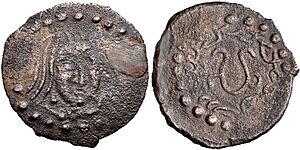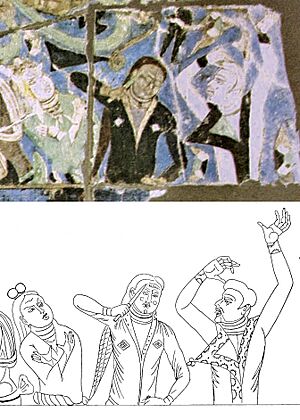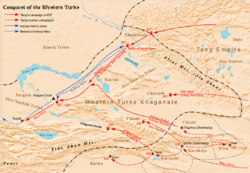Western Turkic Khaganate facts for kids
Quick facts for kids
Western Turkic Khaganate
𐰆𐰣:𐰸:𐰉𐰆𐰑𐰣
On oq budun |
|||||||||||||||||||||||
|---|---|---|---|---|---|---|---|---|---|---|---|---|---|---|---|---|---|---|---|---|---|---|---|
|
|||||||||||||||||||||||
| Status | Khaganate (Nomadic empire) | ||||||||||||||||||||||
| Capital | Navekat (summer capital) Suyab (principal capital) |
||||||||||||||||||||||
| Common languages | Sogdian (coinage, official) Old Turkic |
||||||||||||||||||||||
| Religion | Tengrism Buddhism Zurvanism |
||||||||||||||||||||||
| Khagan of the Western Khaganate | |||||||||||||||||||||||
|
• 587–604
|
Niri Qaghan | ||||||||||||||||||||||
| Yabgu of the Western Khaganate | |||||||||||||||||||||||
|
• 553–576
|
Istämi | ||||||||||||||||||||||
|
• 576–603
|
Tardu | ||||||||||||||||||||||
| Historical era | Early Middle Ages | ||||||||||||||||||||||
| Area | |||||||||||||||||||||||
| 630 | 3,500,000 km2 (1,400,000 sq mi) | ||||||||||||||||||||||
|
|||||||||||||||||||||||
The Western Turkic Khaganate was a large empire ruled by Turkic people in ancient Eurasia. It was also known as the Onoq Khaganate, which means "Ten Arrow People" in Old Turkic. This name came from the ten main groups or divisions that made up the empire.
The Khaganate was formed in the early 7th century (around 603 CE). It happened after the original First Turkic Khaganate split into two parts: a western part and an eastern part.
The main capital city of the Western Turkic Khaganate was Suyab. It was located in what is now Kyrgyzstan. They also had a summer capital called Navekat.
The Western Turkic Khaganate was a powerful nomadic empire. It controlled important trade routes like the Silk Road. However, it eventually became weaker. The powerful Tang dynasty of China took control of it in 657 CE. The Khaganate continued as a smaller state under Chinese rule until it finally ended in 742 CE.
Contents
History of the Western Turkic Khaganate
The first Turkic Khaganate began in 552 CE. It was founded by a leader named Bumin Qaghan in the Mongolian Plateau. This empire quickly grew and spread west towards the Caspian Sea.
Within about 35 years, the western and eastern parts of this large empire became separate. The Western Khaganate became very strong under its leader, Tong Yabghu Qaghan, from 618 to 630 CE.
After Tong Yabghu's death, there were many disagreements and changes in leadership. The empire started to lose some of its land. From 642 CE onwards, the growing Tang dynasty of China began to get involved in the region. The Tang forces eventually defeated the Western Khaganate between 657 and 659 CE.
Western Expansion and Early Years
The Turkic people were one of the few groups to rule both the eastern and central steppe regions. The steppe is a large area of flat, grassy land. These Turkic empires were the first to connect with three major civilizations: Byzantium (the Eastern Roman Empire), Persia, and China.
The Western Turkic Khaganate expanded greatly to the west. A leader named Istämi (553–575 CE) led this expansion. His campaigns started around 554 CE. They moved quickly, reaching the Aral Sea by 555 CE. They pushed many other groups, like the Avars, further west. The Avars eventually reached Hungary.
The Turks then turned southeast. They fought against the Hephthalites, another powerful group. The Turks and the Persians worked together against the Hephthalites. In 565 CE, the Hephthalites were defeated. This allowed the Turks to control important trade cities in a region called Sogdia. This control gave them power over a key part of the Silk Road.
Between 567 and 576 CE, the Turks also took control of the land between the Caspian and Black Seas. This showed how far their empire had spread.
Later Period and Decline
After Istämi, his son Tardush ruled from 575 to 603 CE. He was involved in a civil war with the Eastern Turkic Khaganate. After his death, the two halves of the empire officially split.
Later, Sheguy (610–617 CE) expanded the Western Khaganate again. He took back areas like Tashkent. His brother, Tong Yabghu Qaghan (618–630 CE), was a very strong ruler. His empire stretched from the Tarim Basin to the Caspian Sea. He even met the famous Chinese Buddhist monk Xuanzang. Tong Yabghu also sent his son to fight in Afghanistan, where they established new Turkic states.
After Tong Yabghu was killed, there were many conflicts among different groups within the Khaganate. The Chinese Tang dynasty saw this as a chance to expand.
Tang Campaigns Against the Western Turks
The Tang dynasty launched several military campaigns against the Western Turkic Khaganate. These wars began because the Tang wanted to weaken both the Western and Eastern Turkic empires.
Under Emperor Taizong of Tang, Tang armies attacked areas like Gaochang (640 CE), Karasahr (644 and 648 CE), and Kucha (648 CE). These were important cities in the Western Regions.
The wars continued under Emperor Gaozong of Tang. Finally, in 657 CE, the Tang general Su Dingfang defeated the Western Turkic leader, Ashina Helu. This led to the Tang dynasty taking over the Khaganate.
Tang Protectorate and Final Collapse
After 657 CE, the Western Turkic Khaganate became a state controlled by the Tang dynasty. The Tang set up a system to rule the area. The Western Turks tried to regain control of the Tarim Basin in 670 and 677 CE, but the Tang forces stopped them.
The Tang general Pei Xingjian led armies into the region. He fought against Turkic leaders who rebelled. The Tang dynasty kept control over these areas until the mid-8th century.
The culture of the Tang dynasty and the Turkic soldiers stationed there influenced the region. Turkic people also moved into what is now Xinjiang. The Tang Empire reached its largest size after these campaigns.
However, the Tang, Tibetans, and Muslim Arabs all competed for control of Central Asia. Eventually, the Second Turkic Khaganate (a new Turkic empire) defeated the remaining Western Turkic groups in 712 CE. They absorbed these tribes into their new empire. The Western Turkic Khaganate officially ended in 742 CE.
Relations with Other Empires


In the late 6th century, the Turks became very important in Central Asian trade. They were a link between East Asia and West Asia. Persia and Byzantium were the main powers in West Asia.
The Turks controlled the Sogdian merchant cities along the Oxus River. This gave them strong control over the central part of the Silk Road. This trade route was very important for moving goods like silk between China and the West.
The Turks also had contact with the Byzantine Empire. In 568 CE, a Sogdian merchant named Maniakh led a group from the Turks to Constantinople (the capital of Byzantium). They wanted to trade and form an alliance against the Avars and Persians. A Byzantine official, Zemarchus, traveled back with Maniakh. He wrote an early account of the Turks.
This alliance with Byzantium was important. It helped the Turks in their wars against Persia. For example, in 627 CE, Tong Yabghu Qaghan sent his army to help the Byzantines. They attacked Persian areas and helped the Byzantine emperor Heraclius against the Persians.
The Onoq or Ten Tribes
The name "Onoq" means "Ten Arrows" or "Ten Tribes." This name is key to understanding the Western Turkic Khaganate. Chinese historical records give two main ideas about how these ten tribes came to be.
One idea says that the ten tribes were formed very early. It suggests that Istämi, a younger brother of the first Turkic leader, brought these ten tribes with him when he expanded the empire to the west.
Another idea says that a later leader, Ishbara Tolis, officially divided the state into ten parts in 635 CE. Each part was led by a chief, and each chief was given an "arrow." This is why they were called the "Ten Arrows." He divided these ten arrows into two main groups:
- The five Duolu tribes lived to the east of the Chu River.
- The five Nushibi tribes lived to the west of the Chu River.
These divisions helped organize the Western Turks. The name "ten tribes" became a common way for the Chinese to refer to the Western Turks.
Primary Sources
Afrasiab Murals


The Afrasiab murals are ancient paintings found in Samarkand (in modern-day Uzbekistan). These murals from the 7th century CE show Turkic people. They appear alongside Chinese envoys. The Chinese envoys are carrying silk. The Turkic people are easily recognized by their long braided hair. They are shown as military attendants, not ambassadors.
These paintings give us a unique look at what the Turks wore in the 6th and 7th centuries. They often wore long, sleeved coats with two lapels. They also wore black, sharp-nosed boots. These murals were likely painted between 648 and 651 CE. This was when the Western Turkic Khaganate was nearing its end.
Orkhon Inscriptions
The Orkhon inscriptions are ancient Turkic writings found in Mongolia. They are very important historical records. They mention the "Ten Arrows" people. For example, one inscription talks about how the "On-Oq people suffered a great deal." Another mentions "sons of Ten Arrows." These inscriptions show that the "Ten Arrows" were a well-known group.
Tonyukuk Inscription

The Tonyukuk inscription is another important Turkic stone monument. It also mentions the "Ten Arrows" people. For instance, it says, "The kagan of 'Ten Arrows' was our enemy." It also describes how "All Ten Arrows people started out" for a campaign. These writings confirm the importance of the "Ten Arrows" as a major force in the region.
Rulers of the Western Turkic Khaganate
Yabgus during the United Empire (553–603)
| Yabgu | Reign | Father, Grandfather |
Regnal Name
(Chinese reading) |
Personal Name
(Chinese reading) |
|---|---|---|---|---|
| Istämi | 553–576 | Ashina Tuwu, Ashina |
Shìdiǎn mì Kèhán | 室點密 Shìdiǎnmì |
| Tardu | 576–603 | Istämi, Ashina Tuwu |
Dátóu Kèhán | 玷厥 Dianjue |
Khagans during the Independent Western Khaganate (603–658)
| Kaghan | Reign | Father, Grandfather |
Regnal Name
(Chinese reading) |
Personal Name
(Chinese reading) |
|---|---|---|---|---|
| Niri Qaghan | – | Yangsu Tegin, Muqan Qaghan |
Nílì Kèhán | 向氏 Xiàngshì |
| Heshana Khagan | 604–611 | Niri Qaghan Yansu Tegin |
Chùluó Kèhán | 達曼 Daman |
| Sheguy | 611–618 | Tulu Tegin, Tardu |
Shèguì Kèhán | 射匮 Shèguì |
| Tong Yabghu Qaghan | 618–628 | Tulu Tegin, Tardu |
Tǒng yèhù Kèhán | 統葉 Tǒng yèhù |
| Külüg Sibir | 628–630 | Tardu, Istämi |
Qūlìqí pí Kèhán | 莫贺咄 Mòhèduō |
| Sy Yabghu Khagan | 631–632 | Tong Yabgu Qaghan, Tulu Tegin |
Yǐpí (shā)bōluō sìyèhù Kèhán | 阿史那咥力 Āshǐnà xilì |
| Duolu Qaghan | 633–634 | Bagha Shad, unknown |
Duōlù Kèhán | 阿史那泥孰 Āshǐnà Níshú |
| Ishbara Tolis | 634–639 | Bagha Shad, unknown |
Shābōluō Kèhán | 阿史那咥力 Āshǐnà Tóng |
| Yukuk Shad | 639–642 | Illig Qaghan, Yami Qaghan |
Yǐpí duōlù Kèhán | 阿史那欲谷 Āshǐnà Yùgǔ |
| Irbis Seguy | 642–650 | El Kulug Shad, Ishbara Tolis |
Yǐpí shèkuì Kèhán | 阿史那莫賀咄 Āshǐnà Mòhèduō |
| Ashina Helu | 651–658 | Böri Shad, unknown |
Shābōluō Kèhán | 阿史那賀魯 Āshǐnà Hèlǔ |
- Claimants
- El Kulug Shad 639–640 (Nushibi-chief)
- Irbis Ishbara Yabgu Qaghan 640–641 (Nushibi-chief)
- Later claimants
- Ashina Duzhi 676–679 (allied with Tibetan Empire)
- Ashina Tuizi 693–700 (allied with Tibetan Empire)
Khagans under Tang Control (657–742)
- Kunling Protectorate (657–736)
- Ashina Mishe (657–662)
- Ashina Yuanqing (685–692)
- Ashina Xian (708–717)
- Ashina Zhen (735–736)
- Mengchi Protectorate (657–742)
- Ashina Buzhen (657–667)
- Ashina Huseluo (693–704)
- Ashina Huaidao (704–708)
- Ashina Xin (740–742)
Images for kids
See also
- Eastern Turkic Khaganate
- Tang campaigns against the Western Turks
- Qaghans of the Turkic khaganates
- History of the central steppe
- Khazars
- Oghuz Turks
- Turkic peoples
- Timeline of Turks (500–1300)








